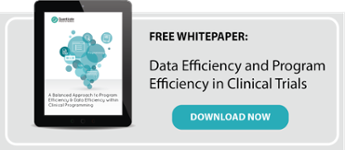
How can the efficiency of a Clinical Research Organization (CRO) be understood? As CROs provide various services to study sponsors, their overall efficiency at providing these services and internal processes to allow these to be delivered can be broken down into a number of elements with their own unique efficiency.
1 - Reactive efficiency (rapid response)
This is how quickly a CRO can respond to immediate short notice resourcing requirements. There are two considerations in play here: whether the CRO has suitably certified and experienced personnel at its disposal, and whether these personnel can be made available to projects when needed. The exact approach will depend upon each customer’s needs and whether there is a desire for ring-fenced dedicated teams, a flexible cross-customer pool or a hybrid across both scenarios. Different sourcing approaches are explored in more detail here. Having an efficient and clear approach to utilizing resource allows the CRO to provide the best resourcing options to meet the client expectations.
1.2 - Contractual processing efficiency (rapid response)
As well as the need to optimize the resourcing response rate for immediate short notice requests, the CRO will also need to ensure that the contracts and proposals team act promptly in the development, production and execution of contractual documentation in order to allow work to commence.
Both parties must ensure that all requirements from the sponsor are identified and agreed. Internal processes at the CRO will determine the speed of contract production: an efficient negotiation and quoting process, including price rates, can increase the speed of contract production, to allow the contract to be issued to the client for authorization.
A fully signed contract prior to commencement of work is a regulatory requirement. Working outside of scope of an existing contract can result in issues. Any additional short-term request received after the contract is signed may result in a change order.
Obtaining agreement from both parties on the scope and requirements of work is a key element of contract development, and the ability to do this efficiently allows the CRO to respond to a short notice request. A lack of agreement on the scope and requirements of work may surprise a sponsor at a later date, and misalignment of expectations between the parties can result in difficulties. Part of a successful partnership between the sponsor and CRO is the governance and agreement to the work that will be delivered.
2 - Personnel efficiency (longer-term response)
This is how fast a CRO can respond to longer term resourcing requirements. This has three elements, recruitment, retention and training. Without the necessary staff to do the job, a CRO will inevitably struggle to respond to resourcing requirements and therefore the recruitment of talented employees is a critical aspect to ensuring successful growth. Like all companies, CROs must focus on retention of staff because it allows for relationships to develop with customers and improves customer care. CRO personnel can effectively become part of a sponsor’s team, indeed certain resourcing models are structured to allow for a CRO to act as an extension arm to the sponsor’s teams. Having solid retention approaches and policies will maximize retention and enable efficiencies in the way customers are supported through minimal re-training or potential service disruption. Beyond making it easier to recruit and retain staff, suitable training will make a CRO more reactively efficient because it increases the CRO’s skills base resulting in a quality service being delivered to the client through a motivated and educated workforce.
3 - Output efficiency
This is how quickly a range of outputs can be produced to the highest quality. Outputs could be anything, including data management provision, clinical programming output, biostatistics output etc. This efficiency contains three variables: the range of outputs to be produced, the speed at which the outputs can be produced and the quality of the outputs being produced.
Depending on what the client wants and can realistically be provided, the CRO can provide certain outputs immediately but may opt to provide more specialized outputs at a later date if the client request is relatively bespoke. The time it takes to produce the outputs is defined with the client and emerging technologies can enable real time visualization of data outputs that can be accessed by a customer on an ad hoc basis instead of having to wait for outputs to be delivered by the CRO. The quality of an output is key. If, for example, any issues are noted on the quality of a Tables, Listings and Figures (TLFs) output, then these cannot be used. Quality is vital for a successful drug submission; therefore, the quality of an output should not be compromised in order to meet the deadline for a deliverable. It is possible for CROs to have metrics of 99.98% for the quality of outputs in a Functional Service Provision relationship.
4 - Service efficiency
CROs provide tangible outputs like tables, figures and databases, but as service providers must also focus on the intangibles of service provision, such as enthusiasm, speed of communication, expectation setting, assertive consultancy and soft skills. A CRO cannot be successful by just being the most efficient provider of tangible outputs, it must also communicate to the client that it is giving the best guidance, is adding the most value and is the most pleasant provider to work with. With visual workflows and project management tools available these soft skills can be improved greatly. Having a project management tool enables communications with the client to be clear and also enables everything to be logged and stored. This allows for a great client experience with the CROs staff as any study member can view the communication log and keep up-to-date with the study requirements, deliverables, milestones etc. The client can also speak to any study member about these details and not a have to wait for the availability of a specific project lead individual. Tools to enhance internal communication between members of the study team (both sponsor and vendor resource) will result in a more positive experience for the client when outsourcing to a CRO.
Summary
In terms of CRO efficiency, the importance of reactive and contractual processing efficiency for a CRO is dependent on the likelihood of clients needing immediate short notice resource. The whole organization should be output efficient to best meet client requirements, whilst keeping service and personnel efficiency in mind to ensure an overall successful long-term partnership between the CRO and sponsor company.
Request a Consultation
Authors note: This blog was originally published on 20/11/2012 and has since been updated.
Related Blog Posts:
- Challenges and Rewards of Working in a Clinical Research Organization
- Making a Clinical Research Organization Project Run Smoothly
- The Benefits of Centralizing Clinical Data Services



